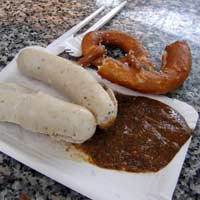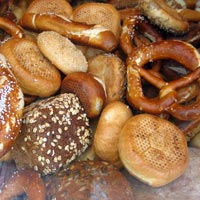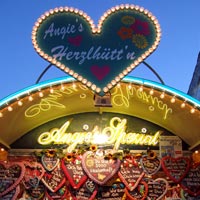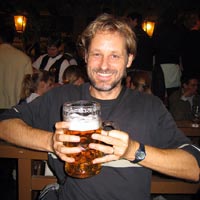The food of Germany
[back to Food Diary Index]
These notes were made during a short trip to Germany. These are just our food experiences and you may have a totally different experience depending on your budget, where you travel and where you eat.
Notes made September 2005
Munich is a very modern city, and the cuisine is similar, very modern and influenced by international styles. Among others, there are many Asian and Italian influenced retuarants. The beer houses however, of which there are many all over town, are usually the ones to serve the more traditional Bavarian food. Apparantly Germans invented the ‘stand up cafe’ system. Usually a cafe/bakery where you can order a snack and coffee to have standing in the shop at a table, very quick and cheap for busy people.
 Sausages
Sausages
Such a huge range of sausages. The most famous of which is the Weiswurst, or white sausage. It is made with a real intestine with white sausage meat. The sausage is boiled and when cooked is sliced open for just the flesh to be eaten from within. The taste is quite mild and herb flavoured. Traditionally served with a Brezen, some sweet mustard and a frothy beer before 12 noon.
Traditional meal
A night out at the Augustiner beer hall allowed us to try some local specialties, including;
- Knodel (sounds like noodle) is flour dumpling which comes in a few different forms;
- maccorni style with a cheese sauce
- round slices with a herb flavour served with a mushroom sauce (flavoured with balsamic vinegar), raw onions and red radish slices
- maccorni style with a cheese sauce
- Leberka is a meat loaf that is made from sausage meat (colour being pinkish), served with creamy potato bake (cold), a fried egg and mustard
- Roasted knodel cut in thin slices and fried with egg and bacon
- a popular larger meal is roast pork with crackling and dumplings
- saurkraut was included in many of the dishes
 Cheese
Cheese
Brie and Camembert cheese are very cheap here and are readily available. A local specialty cheese is Camembert cheese mixed with red peppers cumin and spring onions (?). It comes out a salmony colour and is very delicious and can be eaten with bread as a dip.
Bread or Brot
Lots of quality bread shops, with a large mix of different types from white to hearty grain and seeded breads. Brezen is very common, it is the same as a pretzel, and come plain (which is salted), or with grilled cheese and/or ham. Also lots of pastry options on offer.
Oktoberfest food
Since we happen to be in Munich for Oktoberfest, I have had a chance to experience all the food eaten at Oktoberfest, of which much is typical Bavarian food.
 Sausages of course; many are quite flavoursome with herbs and spices, served in a roll with mustard or tomato sauce
Sausages of course; many are quite flavoursome with herbs and spices, served in a roll with mustard or tomato sauce
- Fish burgers; crumbed and fried with mayonnaise, or raw fish fillet (called roll mop in Australia) in a bun with raw onion and mayo
- Brezen
- Gingerbread hearts; not meant to be eaten, they contain a sweet message written in icing and traditionaly given to your lover
In the tent:
- Knodel; gnocci like dumplings, made from flour served with a cheesy sauce
- half a roast chicken, which is very salty
- fresh sliced radish chips
Nordsee - the takeaway seafood chain from Austria is here as well
Desserts
Strudel - a baked pastry dessert, unlike what I imagined. Soft layers of pastry with fruit layers in between. Apple the most famous, but other fruit fillings are available. Best served warm with cream or ice cream.
Malt like buscuits (as in Hungary) usually a specialty at Christmas time
 Drinks
Drinks
- A grape flavoured sweet syrup which can be mixed with water, wine or champagne
- Beer is very popular, and many litres are consumed by the locals (and also the visitors during Oktoberfest - approximately 8 million litres in fact)
- White beer is what we would call cloudy beer, usually eaten with the white sausage
- MezzoMix - a coca cola product found at the supermarket - half cola, half orange
Do you have feedback, a comment or correction? Let us know
